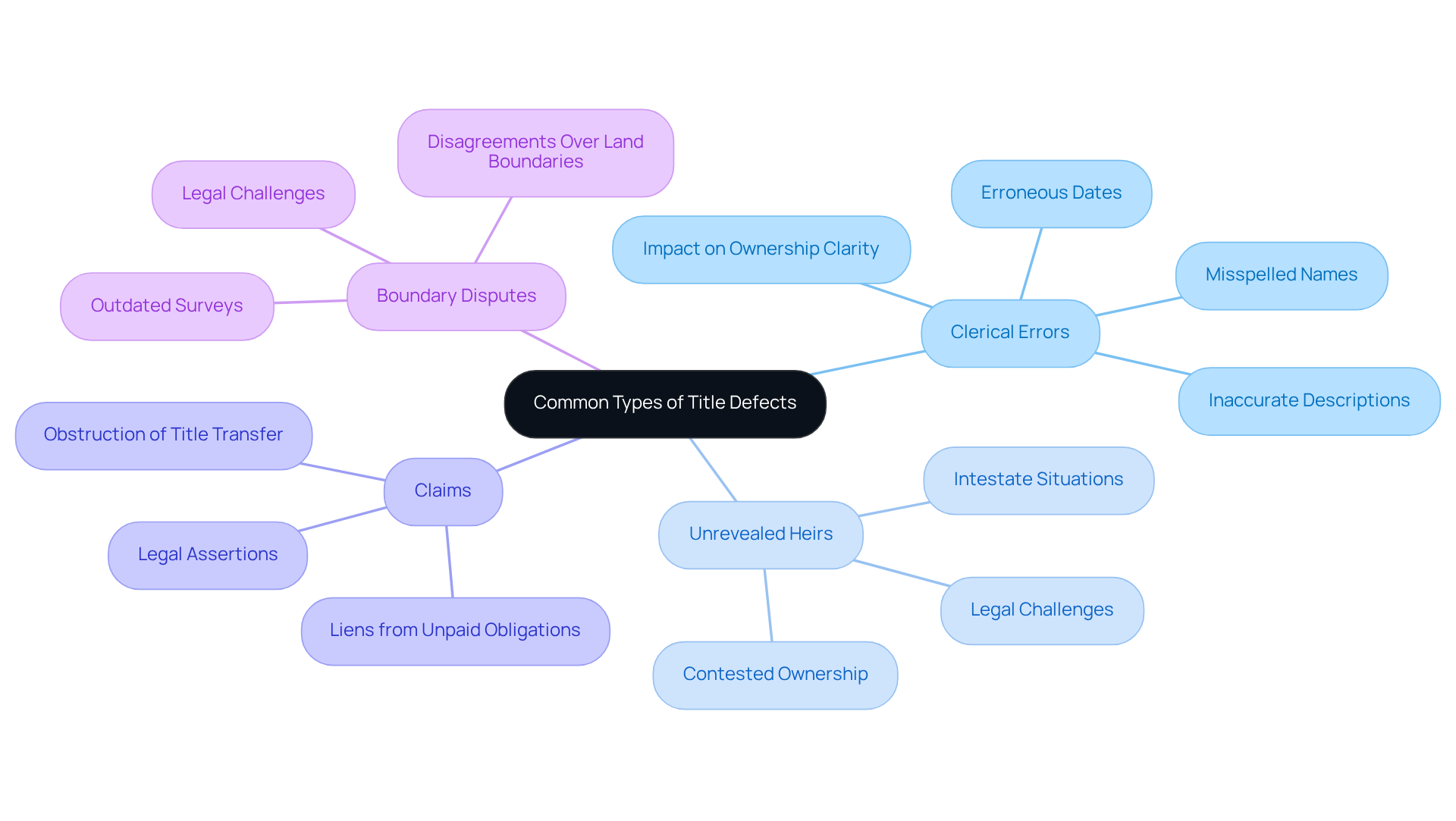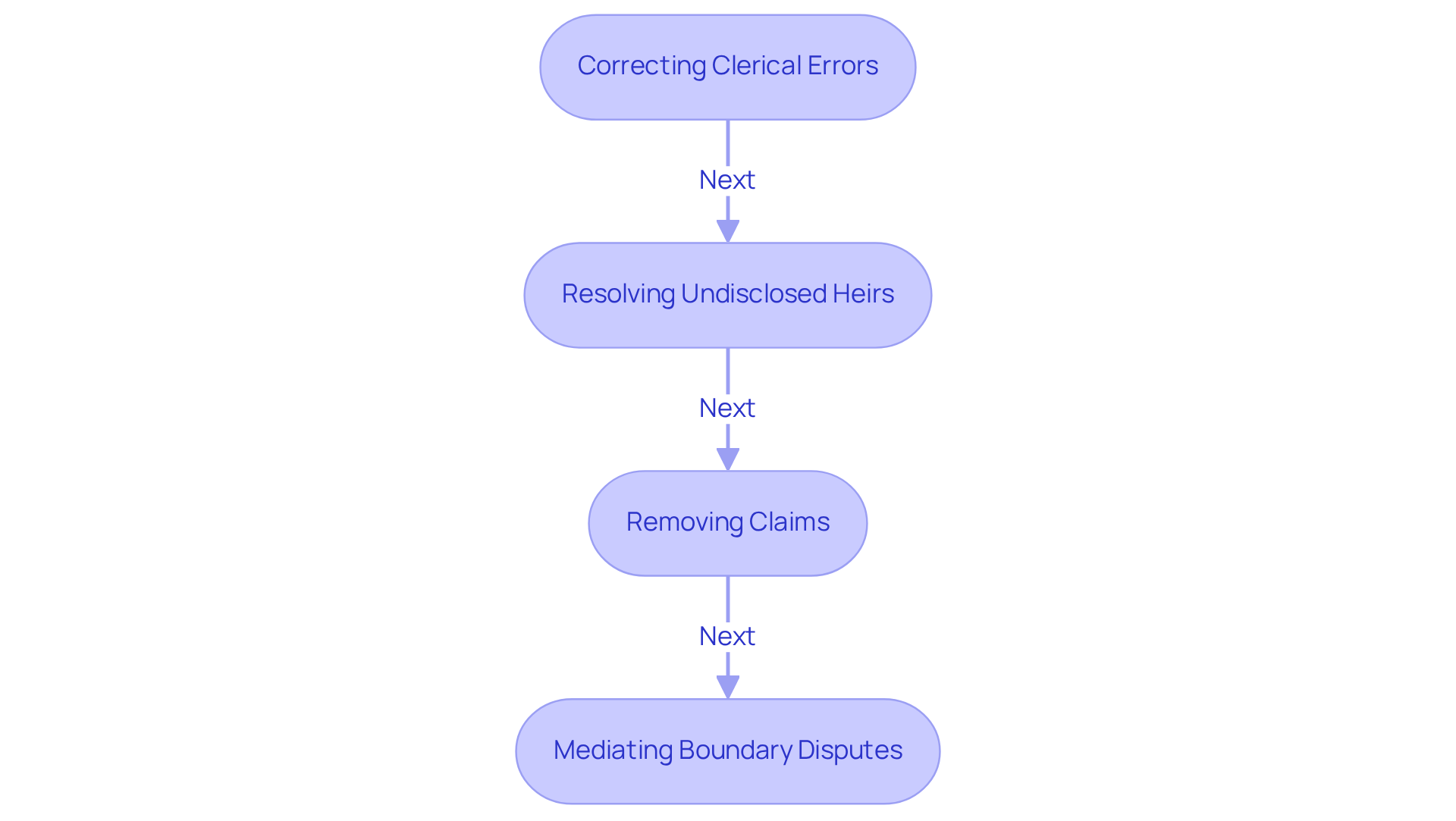Overview
Title defects requiring resolution encompass:
- Clerical errors
- Undisclosed heirs
- Claims against the asset
- Boundary disputes
These issues pose a serious threat to property ownership and complicate real estate transactions. Addressing these challenges through professional searches and legal remedies is not merely advisable; it is essential for ensuring clear ownership and preventing transaction delays. Unresolved title defects can result in significant financial losses and disputes, underscoring the critical need for thorough title research.
Introduction
Understanding the intricacies of property ownership is paramount in real estate. Even minor discrepancies in title can lead to significant complications. Title defects, which can range from clerical errors to undisclosed heirs, pose real threats to clear ownership and can derail transactions if not addressed promptly.
How can real estate professionals navigate these challenges effectively and ensure smooth transactions? This article delves into the types of title defects that require curing, the methods to resolve them, and the innovative technologies that can streamline the process.
Ultimately, these solutions safeguard investments and enhance transaction efficiency.
Define Title Defects: Understanding the Basics
Types of title defects that require curing encompass any irregularities or issues within the chain of title that can jeopardize ownership. These flaws may stem from various sources, including clerical errors, undisclosed heirs, or claims against the asset, which are types of title defects that require curing, such as IRS tax claims and mechanics' liens. For example, unknown liens can emerge from unpaid debts by previous owners, complicating transactions for prospective buyers. According to the 2017 Realtors Confidence Index, '11% of transaction delays are caused by unresolved issues related to ownership of a real estate asset,' highlighting the critical necessity for thorough ownership searches.
Understanding the that require curing is vital for real estate professionals, as these defects can lead to disputes, financial losses, and transaction complications. Common issues include types of title defects that require curing, such as encumbrances, which are rights that others may hold in the property that might not be revealed during a document examination, and boundary disputes arising from conflicting surveys. Moreover, the presence of encumbrances, which are considered types of title defects that require curing, can cloud ownership and necessitate resolution before most buyers will consent to take possession. As Rande Yeager, president of the American Land Association, states, "This clearly demonstrates the importance of a professional search of ownership in all real estate transactions."
By identifying these flaws early, professionals can take proactive measures to rectify the types of title defects that require curing, including obtaining releases for liens and ensuring clear ownership for both buyers and sellers. Industry leaders emphasize the importance of a professional ownership search, stating that most issues, including types of title defects that require curing, can be prevented with appropriate legal counsel during transactions. This proactive strategy not only protects investments but also enhances the overall efficiency of real estate transactions.

Explore Common Types of Title Defects
- Clerical Errors: Mistakes made during the recording of documents can lead to discrepancies in the title. These errors may include misspelled names, inaccurate descriptions, or erroneous dates, all of which can significantly impact ownership clarity.
- Unrevealed Heirs: When an asset owner dies intestate, unrevealed heirs may emerge, asserting their ownership rights. This situation can complicate the title, creating potential legal challenges that must be navigated.
- Claims: A claim represents against an asset due to unpaid obligations. If unresolved, such claims can result in liens, obstructing the transfer of clear title to a new owner.
- Boundary Disputes: Disagreements over land boundaries often arise, particularly when surveys are outdated or flawed. These disputes can lead to legal challenges, ultimately affecting ownership rights and necessitating careful resolution.

Discuss Curing Methods for Title Defects
- Correcting Clerical Errors: Addressing clerical errors requires professionals to file corrective documents with the appropriate recording office. This procedure may entail submitting an affidavit or a correction deed to ensure the precision of . Furthermore, utilizing Parse AI's advanced machine learning tools can expedite this process by automating document processing, ensuring that corrections are made swiftly and accurately.
- Resolving Undisclosed Heirs: Comprehensive property investigations and genealogical research are crucial for identifying undisclosed heirs. Once these heirs are located, engaging in negotiations or legal proceedings may become necessary to resolve any ownership claims. Given that an estimated two-thirds of Americans die without leaving a will, the potential for undisclosed heirs significantly complicates property ownership. Consequently, Parse AI's platform can assist in efficiently extracting critical information from document titles, streamlining the identification of undisclosed heirs. Properties impacted by heirship concerns are among the types of title defects that require curing, surpassing $32 billion in worth and primarily affecting rural regions, which underscores the significance of resolving these ownership defects.
- Removing Claims: To resolve encumbrances, landowners must either clear the related debts or arrange agreements with creditors. After resolution, a release should be filed to clear ownership, ensuring that the asset is free from encumbrances. In addition, Parse AI's research automation can aid in the extraction of pertinent lien information, simplifying the process for researchers to handle and resolve these issues effectively.
- Mediating Boundary Disputes: Engaging in mediation or obtaining updated surveys can effectively resolve boundary disputes. If parties cannot reach an agreement, legal action may be necessary to settle the matter. This proactive approach can prevent costly and time-consuming litigation. By leveraging Parse AI's tools, property researchers can quickly access and analyze property boundaries, assisting in the resolution of disputes before they escalate.

Leverage Technology for Efficient Title Research
The integration of machine learning and optical character recognition markedly enhances the efficiency of document research. These advanced technologies rapidly analyze extensive collections of document titles, extracting critical information and identifying potential defects with impressive accuracy. By automating routine tasks, real estate professionals can redirect their efforts toward more complex issues, consequently accelerating the verification process.
For instance, platforms like Parse AI exemplify how leveraging such technology can result in substantial cost savings, with reports showing significant reductions in time and resources compared to traditional methods. Statistics reveal that AI agents can reduce human workloads by 12.5%, equivalent to five hours weekly, enabling specialists to focus on client communication and intricate problem-solving. As Jeff Bezos noted, AI agents empower specialists to devote more time to these essential tasks, ultimately delivering prompt and reliable outcomes.
Furthermore, with 42% of enterprise-scale companies already utilizing AI and an additional 40% exploring its potential, the adoption of is becoming crucial for maintaining competitiveness and enhancing service quality. However, challenges such as poor data quality (43%) and lack of data availability (38%) persist as significant obstacles in the realm of title research. As the title industry evolves, embracing these technologies is vital for overcoming these challenges and improving overall efficiency.

Conclusion
Understanding the various types of title defects is essential for ensuring clear property ownership and facilitating smooth real estate transactions. These defects can arise from clerical errors, undisclosed heirs, claims against the property, and boundary disputes, creating significant obstacles if not addressed. By recognizing and curing these issues, real estate professionals can protect investments and streamline the buying and selling process.
The article highlights key types of title defects that require curing, including:
- Clerical errors that distort ownership records
- Complications posed by undisclosed heirs
- Challenges presented by claims and boundary disputes
Each of these issues necessitates specific methods for resolution, such as:
- Correcting documentation
- Conducting thorough investigations
- Clearing debts
- Engaging in mediation
Furthermore, the integration of advanced technologies like machine learning and optical character recognition enhances the efficiency of title research, allowing professionals to identify and resolve defects more effectively.
In light of the complexities surrounding title defects, it becomes clear that proactive measures are essential in the real estate sector. Embracing innovative tools and technologies not only aids in overcoming the challenges of title research but also ensures that transactions proceed without unnecessary delays. By prioritizing the identification and curing of title defects, real estate professionals can foster a more efficient market, ultimately benefiting buyers, sellers, and the industry as a whole.
Frequently Asked Questions
What are title defects?
Title defects are irregularities or issues within the chain of title that can jeopardize ownership of a property. They can arise from various sources, such as clerical errors, undisclosed heirs, or claims against the asset.
What are some common types of title defects that require curing?
Common types of title defects that require curing include encumbrances, boundary disputes, unknown liens, and claims such as IRS tax claims and mechanics' liens.
How can title defects affect real estate transactions?
Title defects can lead to disputes, financial losses, and transaction complications, causing delays in the buying or selling process.
What percentage of transaction delays are caused by unresolved ownership issues?
According to the 2017 Realtors Confidence Index, 11% of transaction delays are caused by unresolved issues related to ownership of a real estate asset.
Why is it important for real estate professionals to understand title defects?
Understanding title defects is vital for real estate professionals because these defects can complicate transactions, lead to disputes, and result in financial losses.
What proactive measures can be taken to address title defects?
Proactive measures include conducting thorough ownership searches, obtaining releases for liens, and seeking appropriate legal counsel during transactions to ensure clear ownership.
What role does a professional ownership search play in real estate transactions?
A professional ownership search is crucial as it can identify potential title defects early, allowing for timely resolution and preventing issues that could hinder the transaction process.




